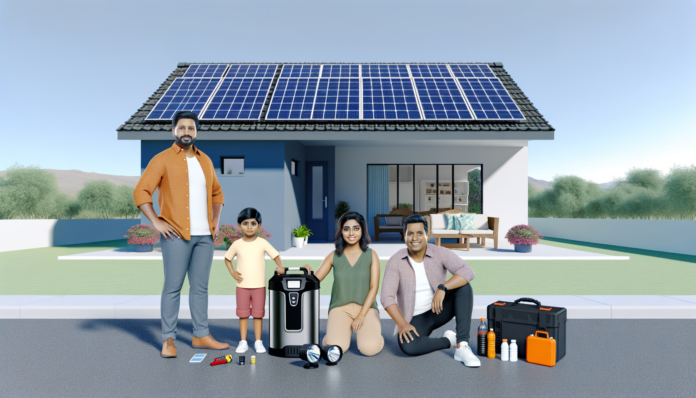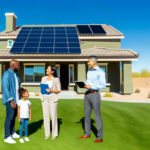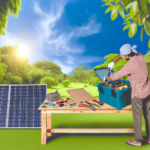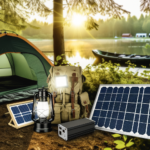Introduction to Solar Preparedness
The Importance of Solar Power in Disaster Scenarios
In recent years, the world has witnessed an alarming increase in the frequency and severity of natural disasters. From hurricanes and earthquakes to wildfires and floods, these catastrophic events pose significant challenges to communities worldwide. In the face of such adversity, the role of renewable energy, particularly solar power, has emerged as a beacon of hope, playing a crucial role in disaster preparedness and recovery efforts.
One of the primary advantages of solar energy in disaster scenarios is its reliability. Traditional power grids are susceptible to damage during disasters, often exacerbating the impact by leaving communities without electricity. Solar panels, however, operate independently and can continue generating power even when the main grid fails, providing a stable energy source for essential services. Additionally, solar power offers the flexibility of off-grid solutions, making it an ideal choice for remote or disaster-stricken areas with limited access to conventional power sources. Off-grid solar systems can be rapidly deployed to power emergency shelters, medical facilities, and communication centers, ensuring that critical infrastructure remains operational.
Overview of Solar Preparedness
Solar preparedness involves the strategic planning and implementation of solar power systems to ensure a reliable energy supply during and after disasters. This preparedness encompasses several key components, including the installation of solar panels, battery storage systems, and the integration of these systems into existing infrastructure. The goal is to create a resilient energy network that can withstand the impacts of natural disasters and provide continuous power to essential services.
Solar preparedness is not just about having solar panels installed; it also involves regular maintenance, system monitoring, and having a clear understanding of how to operate and troubleshoot the system during emergencies. By incorporating solar energy into disaster preparedness plans, communities can enhance their resilience, reduce their dependence on traditional power grids, and ensure a more sustainable recovery process.
Target Audience and Their Needs
The target audience for solar preparedness includes a wide range of stakeholders, each with unique needs and considerations:
1. **Homeowners and Families**: Individuals and families looking to ensure a reliable power supply during disasters. Their needs include affordable and easy-to-install solar power systems, as well as guidance on maintenance and emergency protocols.
2. **Community Leaders and Planners**: Local government officials and community planners responsible for disaster preparedness and response. They require scalable solar solutions that can be integrated into community infrastructure, such as emergency shelters, hospitals, and communication centers.
3. **Businesses and Organizations**: Companies and organizations that need to maintain operations during disasters. Their focus is on robust and high-capacity solar power systems that can support critical business functions and minimize downtime.
4. **Emergency Responders and Relief Agencies**: Organizations involved in disaster response and recovery efforts. They need portable and rapidly deployable solar solutions to power emergency equipment, communication devices, and medical facilities in disaster-affected areas.
5. **Policy Makers and Advocates**: Individuals and groups advocating for sustainable energy policies and disaster resilience. They seek comprehensive information on the benefits of solar power in disaster scenarios and the necessary regulatory frameworks to support widespread adoption.
By addressing the specific needs of these diverse groups, solar preparedness can play a pivotal role in enhancing disaster resilience and ensuring a reliable power supply during emergencies.
Understanding Solar Power Systems
Basic Components of a Solar Power System
A solar power system is composed of several key components that work together to convert sunlight into usable electricity. The primary components include:
- Solar Panels: These are the most visible part of the system and are responsible for capturing sunlight and converting it into direct current (DC) electricity.
- Inverter: The inverter converts the DC electricity generated by the solar panels into alternating current (AC) electricity, which is the standard used by most household appliances.
- Battery Storage: Batteries store excess electricity generated during the day for use at night or during power outages, ensuring a continuous power supply.
- Charge Controller: This device regulates the voltage and current coming from the solar panels to the batteries, preventing overcharging and extending battery life.
- Mounting System: The mounting system secures the solar panels to rooftops or the ground, ensuring they are positioned to capture maximum sunlight.
Types of Solar Power Systems
There are several types of solar power systems, each suited to different needs and applications:
- Grid-Tied Systems: These systems are connected to the local utility grid. They allow homeowners to use solar power when available and draw from the grid when it is not. Excess electricity can be fed back into the grid, often resulting in credits or payments from the utility company.
- Off-Grid Systems: Off-grid systems are completely independent of the utility grid. They rely on battery storage to provide electricity when solar power is not available, making them ideal for remote locations or areas prone to frequent power outages.
- Hybrid Systems: Hybrid systems combine the features of both grid-tied and off-grid systems. They are connected to the grid but also have battery storage to provide backup power during outages. This setup offers the flexibility of grid-tied systems with the reliability of off-grid systems.
Advantages of Solar Power in Emergencies
Solar power offers numerous advantages during emergencies, making it a vital component of disaster preparedness:
- Reliability: Solar power systems can provide a continuous source of electricity even when the traditional power grid is down. This is crucial for powering essential services such as lighting, refrigeration, and medical equipment.
- Portability: Portable solar panels and solar-powered generators can be quickly deployed to disaster-stricken areas, providing immediate relief and support to emergency response teams.
- Sustainability: Solar energy is a renewable resource that does not rely on fossil fuels, making it a more sustainable and environmentally friendly option compared to traditional generators.
- Low Maintenance: Solar panels have a long lifespan and require minimal maintenance, making them a cost-effective solution for long-term disaster preparedness.
- Scalability: Solar power systems can be easily scaled up or down to meet varying energy needs, from small portable units to large installations for critical infrastructure.
In summary, understanding the basic components, types, and advantages of solar power systems is essential for leveraging this technology in disaster preparedness. Solar power not only provides a reliable and sustainable source of energy during emergencies but also offers flexibility and scalability to meet diverse needs.
Assessing Your Solar Power Needs
Evaluating Energy Requirements
Before investing in a solar power system, it is crucial to evaluate your energy requirements. This involves understanding your current energy consumption and anticipating future needs. Start by reviewing your electricity bills to determine your average monthly and annual energy usage. Pay attention to seasonal variations, as energy consumption can fluctuate throughout the year.
To get a more accurate assessment, consider the following steps:
- Identify Essential Loads: List the appliances and systems that are critical during a disaster, such as refrigerators, medical equipment, communication devices, and lighting.
- Calculate Total Wattage: Sum the wattage of all essential loads to determine the total power requirement. This will help you size your solar power system appropriately.
- Consider Future Expansion: Account for any future additions to your household or business that may increase energy consumption, such as new appliances or additional family members.
By thoroughly evaluating your energy requirements, you can ensure that your solar power system will meet your needs during both normal operations and emergency situations.
Choosing the Right Solar Power System
Selecting the right solar power system involves understanding the different types available and determining which one best suits your needs. There are three main types of solar power systems:
- Grid-Tied Systems: These systems are connected to the local utility grid and allow you to draw power from the grid when solar production is insufficient. They are typically less expensive but do not provide power during grid outages unless paired with battery storage.
- Off-Grid Systems: These systems are completely independent of the utility grid and rely on batteries to store excess energy for use during periods of low solar production. They are ideal for remote locations but can be more expensive due to the need for extensive battery storage.
- Hybrid Systems: Combining elements of both grid-tied and off-grid systems, hybrid systems are connected to the grid but also include battery storage. This allows for greater flexibility and reliability, as you can draw power from the grid, solar panels, or batteries as needed.
When choosing a solar power system, consider factors such as your budget, location, and energy requirements. Consulting with a professional solar installer can also help you make an informed decision.
Scalability and Future-Proofing
Investing in a solar power system is a long-term commitment, so it is essential to consider scalability and future-proofing. This ensures that your system can adapt to changing energy needs and technological advancements.
Here are some tips for future-proofing your solar power system:
- Modular Design: Opt for a modular system that allows for easy expansion. This way, you can add more solar panels or battery storage as your energy needs grow.
- Advanced Inverters: Choose inverters that are compatible with future technologies, such as smart grids and advanced energy management systems. This will help you integrate new features and improvements as they become available.
- Regular Maintenance: Implement a routine maintenance schedule to keep your system in optimal condition. Regular inspections and timely repairs can extend the lifespan of your solar power system and ensure its efficiency.
- Stay Informed: Keep up-to-date with advancements in solar technology and industry trends. This knowledge will help you make informed decisions about upgrades and enhancements to your system.
By considering scalability and future-proofing, you can maximize the return on your investment and ensure that your solar power system remains reliable and efficient for years to come.
Installation and Maintenance
DIY vs. Professional Installation
When it comes to installing a solar power system, one of the first decisions you’ll need to make is whether to go the DIY route or hire a professional installer. Each option has its own set of advantages and considerations.
DIY Installation:
- Cost Savings: One of the primary benefits of DIY installation is the potential for cost savings. By handling the installation yourself, you can avoid labor costs associated with professional services.
- Learning Experience: Installing your own solar power system can be a rewarding educational experience, giving you a deeper understanding of how the system works.
- Flexibility: DIY installation allows you to work on your own schedule, which can be particularly useful if you have time constraints.
Professional Installation:
- Expertise: Professional installers bring a wealth of experience and technical know-how, ensuring that your system is installed correctly and efficiently.
- Warranty and Support: Many professional installations come with warranties and ongoing support, providing peace of mind in case any issues arise.
- Compliance: Professionals are well-versed in local regulations and building codes, ensuring that your installation meets all necessary requirements.
Routine Maintenance Tips
Maintaining your solar power system is crucial for ensuring its longevity and optimal performance. Here are some routine maintenance tips to keep your system running smoothly:
- Regular Cleaning: Dust, dirt, and debris can accumulate on solar panels, reducing their efficiency. Clean your panels with water and a soft brush or cloth every few months, or more frequently if you live in a particularly dusty area.
- Inspect for Damage: Periodically inspect your solar panels and other system components for any signs of damage, such as cracks or loose connections. Address any issues promptly to prevent further damage.
- Monitor Performance: Use a monitoring system to keep track of your solar power output. Sudden drops in performance can indicate a problem that needs attention.
- Check Inverter: The inverter is a critical component of your solar power system. Ensure it is functioning correctly by checking the display for any error messages and verifying that it is producing the expected output.
- Trim Nearby Trees: Ensure that trees or other vegetation do not cast shadows on your solar panels, as shading can significantly reduce their efficiency.
Troubleshooting Common Issues
Even with regular maintenance, you may encounter some common issues with your solar power system. Here are a few troubleshooting tips:
- Low Power Output: If you notice a drop in power output, first check for any obstructions on the panels. If the panels are clean and unobstructed, inspect the inverter for error messages. If the issue persists, it may be time to consult a professional.
- Inverter Issues: If your inverter is not working correctly, check the manufacturer’s manual for troubleshooting steps. Common issues include loose connections or a tripped breaker. If you cannot resolve the issue, contact the manufacturer or a professional installer.
- Battery Storage Problems: If you have a battery storage system and it is not holding a charge, check the connections and ensure that the battery is not damaged. Battery issues can be complex, so it may be best to consult a professional for a thorough diagnosis.
- Monitoring System Errors: If your monitoring system is not displaying data correctly, check the internet connection and ensure that the monitoring device is properly connected to the inverter. Restarting the monitoring system can also resolve minor issues.
By following these installation and maintenance guidelines, you can ensure that your solar power system remains efficient and reliable, providing you with a sustainable source of energy for years to come.
Safety Considerations
Ensuring Safe Installation
The safe installation of solar power systems is paramount, especially in disaster-prone areas. Proper installation not only ensures the system’s efficiency but also minimizes risks associated with electrical faults and structural failures. Here are some key points to consider:
- Professional Assessment: Before installation, a thorough site assessment by certified professionals is crucial. This includes evaluating the roof’s structural integrity, shading analysis, and electrical system compatibility.
- Compliance with Standards: Ensure that the installation complies with local building codes and standards. This includes using certified equipment and following manufacturer guidelines.
- Weatherproofing: Given the likelihood of extreme weather conditions, all components should be weatherproofed. This includes using corrosion-resistant materials and ensuring that all electrical connections are sealed against moisture.
- Proper Mounting: Solar panels should be securely mounted to withstand high winds and other environmental stresses. This often involves using specialized mounting hardware designed for the specific type of roof or ground installation.
Battery Storage Safety
Battery storage systems are a critical component of solar power setups, especially for ensuring power availability during disasters. However, they come with their own set of safety considerations:
- Proper Ventilation: Batteries, especially those using lithium-ion technology, can generate heat. Proper ventilation is essential to prevent overheating and potential fire hazards.
- Safe Location: Batteries should be installed in a location that is both secure and accessible. They should be kept away from flammable materials and in a place where they are protected from flooding or other environmental hazards.
- Regular Maintenance: Routine checks and maintenance are crucial for battery safety. This includes monitoring charge levels, inspecting for physical damage, and ensuring that all connections are secure.
- Emergency Shutoff: An emergency shutoff mechanism should be in place to quickly disconnect the battery system in case of a malfunction or external threat.
Emergency Protocols and Best Practices
Having well-defined emergency protocols and best practices can significantly enhance the safety and effectiveness of solar power systems during disasters:
- Training and Education: Ensure that all users and maintenance personnel are adequately trained in the operation and emergency procedures of the solar power system. This includes understanding how to safely shut down the system if needed.
- Regular Drills: Conduct regular emergency drills to ensure that everyone knows how to respond in case of a system failure or external threat. This helps in identifying any gaps in the emergency plan and improving overall preparedness.
- Backup Systems: While solar power systems are reliable, having a backup power source, such as a generator, can provide an additional layer of security. Ensure that the backup system is also well-maintained and ready for use.
- Communication Plan: Establish a clear communication plan to keep all stakeholders informed during an emergency. This includes having contact information for emergency services, maintenance personnel, and utility companies readily available.
By adhering to these safety considerations, you can ensure that your solar power system not only provides reliable energy during disasters but also operates safely and efficiently.
Maximizing Efficiency and Performance
Optimizing Solar Panel Placement
The efficiency of a solar power system is heavily influenced by the placement of the solar panels. **Optimal placement** ensures maximum sunlight exposure, which is crucial for energy generation. Here are some key considerations:
- Orientation and Tilt: Solar panels should ideally face true south in the Northern Hemisphere and true north in the Southern Hemisphere. The tilt angle should be adjusted according to your latitude to maximize exposure to the sun throughout the year.
- Avoiding Shading: Even partial shading can significantly reduce the efficiency of solar panels. Ensure that there are no obstructions like trees, buildings, or chimneys casting shadows on the panels.
- Roof Condition: The roof should be in good condition to support the weight of the panels and withstand weather conditions. If the roof is old or damaged, consider repairs or replacement before installation.
- Ground-Mounted Systems: If roof space is limited or not ideal, ground-mounted systems can be an alternative. These systems offer flexibility in placement and can be adjusted for optimal tilt and orientation.
Energy Storage Solutions
Energy storage is a critical component of a solar power system, especially during disasters when grid power may be unavailable. **Battery storage systems** allow you to store excess energy generated during the day for use at night or during power outages. Key points to consider include:
- Battery Types: Common types include lead-acid, lithium-ion, and flow batteries. Lithium-ion batteries are popular due to their high energy density, longer lifespan, and lower maintenance requirements.
- Capacity and Scalability: Choose a battery system with sufficient capacity to meet your energy needs during outages. Consider systems that allow for scalability, so you can add more storage as your energy needs grow.
- Integration with Solar Systems: Ensure that the battery system is compatible with your solar power system. Some systems come with integrated inverters and charge controllers, simplifying the installation process.
- Backup Power: In addition to daily use, ensure that your battery system can provide reliable backup power during emergencies. This includes critical loads like medical equipment, communication devices, and essential lighting.
Monitoring and Managing Energy Use
Effective monitoring and management of energy use are essential for maximizing the performance and efficiency of your solar power system. Here are some strategies:
- Energy Monitoring Systems: Install an energy monitoring system to track the performance of your solar panels and battery storage. These systems provide real-time data on energy production and consumption, helping you identify inefficiencies and optimize usage.
- Smart Inverters: Smart inverters can optimize the energy flow between your solar panels, battery storage, and the grid. They can also provide valuable data on system performance and help in managing energy loads.
- Load Management: Prioritize essential loads during power outages to ensure critical devices remain operational. Use energy-efficient appliances and LED lighting to reduce overall energy consumption.
- Regular Maintenance: Regularly inspect and maintain your solar power system to ensure it operates at peak efficiency. This includes cleaning the panels, checking for shading issues, and ensuring all components are functioning correctly.
By optimizing solar panel placement, investing in robust energy storage solutions, and effectively monitoring and managing energy use, you can ensure that your solar power system provides reliable and efficient power during disasters. These steps not only enhance the performance of your system but also contribute to a more resilient and sustainable energy future.
Conclusion and Future Trends
Recap of Key Points
As we have explored throughout this article, solar preparedness is a crucial aspect of ensuring safety and maintaining power during disasters. We began by understanding the importance of solar power in disaster scenarios and identified the target audience and their specific needs. We then delved into the basic components and types of solar power systems, highlighting their advantages in emergencies. Assessing energy requirements, choosing the right system, and considering scalability were discussed to help readers make informed decisions. Installation and maintenance tips, along with safety considerations, were provided to ensure the longevity and safe operation of solar power systems. Finally, we examined ways to maximize efficiency and performance through optimal panel placement, energy storage solutions, and energy management.
Emerging Technologies in Solar Power
The field of solar power is continuously evolving, with emerging technologies promising to enhance efficiency, reliability, and accessibility. One notable advancement is the development of *bifacial solar panels*, which can capture sunlight on both sides, significantly increasing energy output. Additionally, *perovskite solar cells* are gaining attention for their potential to offer higher efficiency at a lower cost compared to traditional silicon-based cells.
Energy storage technologies are also advancing, with innovations such as *solid-state batteries* and *flow batteries* offering longer lifespans and greater safety. These advancements are crucial for ensuring that solar power systems can provide reliable energy during extended outages.
Moreover, the integration of *smart grid technology* and *Internet of Things (IoT)* devices allows for better monitoring and management of energy use, optimizing the performance of solar power systems. These technologies enable real-time data analysis and remote control, making it easier to maintain and troubleshoot systems.
Final Thoughts on Solar Preparedness
In conclusion, solar preparedness is not just about having a backup power source; it is about creating a resilient and sustainable energy infrastructure that can withstand and adapt to disasters. By investing in solar power systems, individuals and communities can ensure continuous access to electricity, reduce dependency on fossil fuels, and contribute to environmental sustainability.
As technology continues to advance, the potential for solar power to play a pivotal role in disaster preparedness and response will only grow. It is essential for individuals, businesses, and policymakers to stay informed about these developments and consider integrating solar power into their disaster preparedness plans.
By embracing solar preparedness, we can build a more resilient future, where communities are better equipped to handle emergencies and recover more quickly. The journey towards solar preparedness is an investment in safety, sustainability, and peace of mind.






